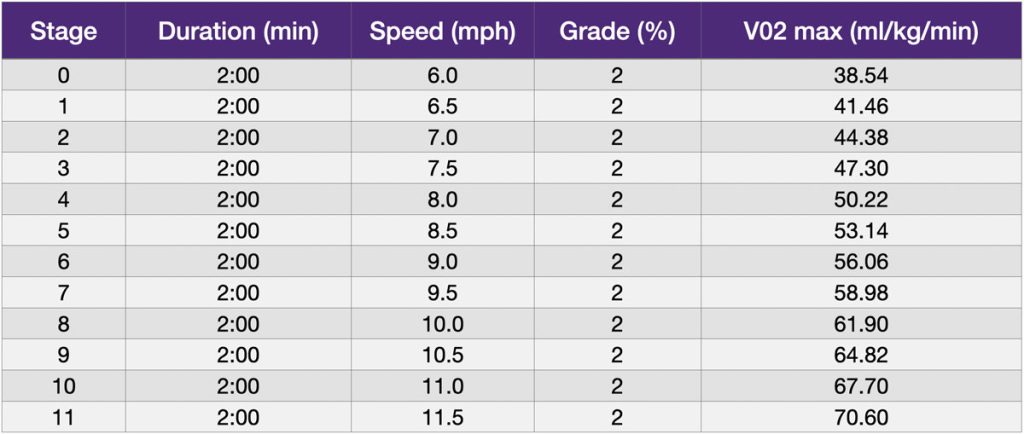THE BEEP TEST
The Beep Test, also known as the shuttle run test, is a popular endurance fitness test used worldwide for its simplicity and minimal equipment needs. Participants run back and forth between two markers 20 meters apart in time to audio beeps that increase in speed. This test is favored for its ability to test large groups simultaneously and is recognized under various names like the bleep test, PACER, and MSFT. It’s notable for its extensive research base and availability of resources for conducting, scoring, and interpreting the test. For detailed information, visit HERE.

The Treadmill Test
The treadmill fitness test outlined involves a dynamic warm-up, followed by a 5-minute general warm-up to start. The test progresses through stages with set durations of 2 minutes each, where the treadmill’s speed increases while maintaining a 2% grade. Heart rate is recorded every two minutes at the beginning of each stage. The test concludes when the participant stops running. A 1-minute recovery rate is monitored post-test, and a cool-down phase wraps up the session. The table provided lists the treadmill speed in miles per hour for each stage and corresponding VO2 max values.

The 30-15 Intermittent Fitness Test
The 30-15 Intermittent Fitness Test (30-15 IFT) is a running test that consists of 30-second back-and-forth runs separated by 15-second passive recovery periods. It’s designed to improve run-based high-intensity interval training (HIIT) prescription. The test leads to a particular speed, the final intermittent running velocity (VIFT), which accounts for various qualities demanded during intermittent back-and-forth runs. These qualities include the explosive power of the lower limbs, aerobic capabilities, and the capacity to recover between exercise bouts. The 30-15 IFT is precise in individualizing short intermittent run distances for subjects with different aerobic or anaerobic profiles. Utilizing VIFT as the reference speed to determine the intermittent running distances allows a certain level of cardiorespiratory demand to be reached with low inter-individual differences compared to using the maximal aerobic speed determined in a continuous form.
The Science Behind VIFT and Intermittent Running
The 30-15 IFT has been studied for its reliability and usefulness across different sports, including rugby league and female soccer players. It has been found to be both reliable and useful for assessing intermittent fitness, with a small change in VIFT being significant for indicating a ‘real’ change in fitness levels. Coaches and trainers utilize the 30-15 IFT to monitor players’ fitness and prescribe intermittent training, valuing the test for its ability to measure and influence high-intensity training effectively.
Adaptations for Different Sports
There are four versions of the 30-15 IFT to suit various sports and fields of play, including adaptations for team sports like handball and soccer, smaller courts like those used in basketball, a straight-line version for runners on a 400-m track, and a version specifically for ice hockey. The test’s versatility and efficiency make it a preferred tool for fitness testing in elite sports, allowing coaches to assess players and prescribe running conditioning programs based on the results.
The Expert Behind the Test
The creator of the 30-15 IFT, Martin Buchheit, is a strength and conditioning coach turned sports scientist. He focuses on football (soccer) and seeks to improve players’ physical and technical potential through scientific approaches.
Accessing Resources and Further Reading
For further detailed insights and access to resources regarding the 30-15 Intermittent Fitness Test, visit the dedicated website www.30-15ift.com. It hosts a range of articles, videos, and testimonials on the test’s application and benefits in sports performance.
Test Example
Athletes must run back and forth between the two lines set 40m apart (Figure 1) at a speed governed by an audio “beep.” As the individual progresses through the levels, the time between the beeps decreases, giving the individual less time to complete each shuttle, thus increasing the speed/intensity of the test.
The two 3m zones in the middle of the testing area (6m in total) exist so the athletes can gauge the required running speed and therefore adjust their speed accordingly (i.e., speed-up or slow-down). The two 3m end zones/turning lines also help guide the athlete to adjust/maintain their speed. During the 15-second recovery period, athletes must walk in a forward direction towards the closest 3m zone, where they will start the next running stage.
Athletes must consistently reach the next 3m zone – either the middle one or the end zone. Failure to reach the next 3m zone on three consecutive occasions results in elimination from the test.
Valuable Downloads
The 30-15 Intermittent Fitness Test website downloads section offers articles and Excel spreadsheets for High-Intensity Interval Training (HIIT) prescriptions. These resources are provided in a password-protected zip file. To access the files, visitors must complete a form to receive the password. Additionally, there is an option to report any bugs found to help improve the test. For more information and to download the materials, please visit 30-15ift.com/downloads.
Additional Resources